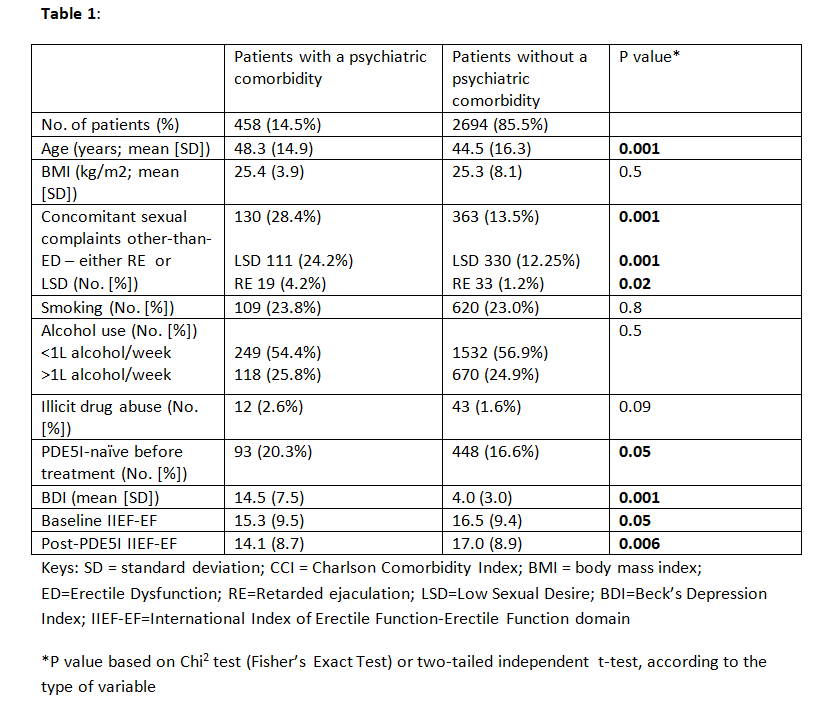Back
Poster, Podium & Video Sessions
Moderated Poster
MP38: Sexual Function/Dysfunction: Basic Research & Pathophysiology
MP38-20: Sexual dysfunction issues among men with psychiatric comorbidities: a management challenge?
Sunday, May 15, 2022
7:00 AM – 8:15 AM
Location: Room 222
Nicolò Schifano*, Milan, Italy, Paolo Capogrosso, Varese, Italy, Giuseppe Fallara, Edoardo Pozzi, Federico Belladelli, Luigi Candela, Christian Corsini, Massimiliano Raffo, Antonio Costa, Daniele Cignoli, Alessia d'Arma, Luca Boeri, Eugenio Ventimiglia, Rayan Matloob, Milan, Italy, Vincenzo Mirone, Naples, Italy, Federico Dehò, Varese, Italy, Francesco Montorsi, Andrea Salonia, Milan, Italy
- NS
Poster Presenter(s)
Introduction: Sexual dysfunction (SD), including erectile dysfunction (ED), low sexual desire (LSD), orgasmic and ejaculatory dysfunction are frequent complaints among patients with affective disorders and other psychiatric comorbidities. These SD-complaints may commonly arise or worsen with the intake of psychotropic medications. The evidence available regarding these issues management in the real-life practice is currently rather limited. We aimed to describe the clinical features of these patients and their clinical response to PDE5 inhibitors (PDE5Is).
Methods: Socio-demographic and clinical data from 3152 consecutive patients presenting with a primary complaint of ED with or without concomitant SD were retrospectively analysed. Patients with an active diagnosis of affective disorder and taking on a regular basis a psychotropic medication (e.g., antidepressants, mood-stabilizers, antipsychotics and anti-anxiety medications) and those with a Beck’s Depression Index (BDI) >10 were considered having a psychiatric comorbidity. Descriptive statistics tested clinical differences between patients with and without a psychiatric comorbidity. Linear multivariate analysis investigated the association between the clinical features and the post-PDE5I IIEF-EF.
Results: Overall, 14.5% of the patients had a psychiatric comorbidity. Among the baseline-clinical-features, age, concurrent sexual complaints other-than-ED, PDE5I-naïve status at first clinical evaluation, BDI, baseline and post-PDE5I IIEF-EF were significantly different among the patients with a psychiatric comorbidity vs. the remaining (all p<0.05) (Table 1). At multivariate analysis, the existence of a psychiatric comorbidity (B=-3.0,p=0.04) and a Charlson Comorbidity Index (CCI)>0 (B=-2.5,p=0.02) predicted lower post-PDE5I IIEF-EF; whilst age was non-significantly associated.
Conclusions: Patients with a psychiatric comorbidity and complaining of SD are frequently encountered in the everyday clinical practice. PDE5Is may be an effective strategy to deal even with these patients, although the efficacy of this strategy may be sub-optimal for some patients, thus outlining the importance of a personalized therapeutic work-up.
Source of Funding: No source of funding to be disclosed

Methods: Socio-demographic and clinical data from 3152 consecutive patients presenting with a primary complaint of ED with or without concomitant SD were retrospectively analysed. Patients with an active diagnosis of affective disorder and taking on a regular basis a psychotropic medication (e.g., antidepressants, mood-stabilizers, antipsychotics and anti-anxiety medications) and those with a Beck’s Depression Index (BDI) >10 were considered having a psychiatric comorbidity. Descriptive statistics tested clinical differences between patients with and without a psychiatric comorbidity. Linear multivariate analysis investigated the association between the clinical features and the post-PDE5I IIEF-EF.
Results: Overall, 14.5% of the patients had a psychiatric comorbidity. Among the baseline-clinical-features, age, concurrent sexual complaints other-than-ED, PDE5I-naïve status at first clinical evaluation, BDI, baseline and post-PDE5I IIEF-EF were significantly different among the patients with a psychiatric comorbidity vs. the remaining (all p<0.05) (Table 1). At multivariate analysis, the existence of a psychiatric comorbidity (B=-3.0,p=0.04) and a Charlson Comorbidity Index (CCI)>0 (B=-2.5,p=0.02) predicted lower post-PDE5I IIEF-EF; whilst age was non-significantly associated.
Conclusions: Patients with a psychiatric comorbidity and complaining of SD are frequently encountered in the everyday clinical practice. PDE5Is may be an effective strategy to deal even with these patients, although the efficacy of this strategy may be sub-optimal for some patients, thus outlining the importance of a personalized therapeutic work-up.
Source of Funding: No source of funding to be disclosed


.jpg)
.jpg)